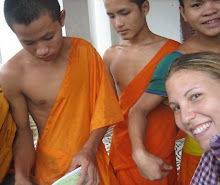 Today is Earth Overshoot Day, meaning that at the end of this 267th day of our calendar year, humanity will have used the biosphere's entire capacity for the year 2009.
Today is Earth Overshoot Day, meaning that at the end of this 267th day of our calendar year, humanity will have used the biosphere's entire capacity for the year 2009.When we wake up tomorrow, we will be in "ecological deficit" and will start utilizing resources at a rate faster than what the planet can regenerate in a calendar year. To put clearly, we have used in less than 10 months what the Earth normally takes a whole year to produce - in terms of natural resources and in terms of CO2 quota - the CO2 Earth has the capacity to reabsorb by forests or seas.
According to the Global Footprint Network, which measures human impact on the Earth, "we currently maintain this overshoot by liquidating the planet’s natural resources. For example we can cut trees faster than they re-grow, and catch fish at a rate faster than they repopulate. While this can be done for a short while, overshoot ultimately leads to the depletion of resources on which our economy depends."
Overshoot started in 1986. Up until then, humanity consumed resources and produced carbon dioxide at a rate consistent with what the planet could produce and reabsorb. Ten years later, in 1996, humanity was using 15 percent more resources in a year than the planet could supply, with Earth Overshoot Day falling in November. In 2009, with our growing population and energy demands, we are now requiring resources at a rate of 40 percent faster than the planet can produce them.
The "good" news is that in 2008, Earth Overshoot Day fell on September 23rd, so it looks like we have gained two days in a year. I'm not sure why that is, if it's a result of successful measures governments have taken to curb their CO2 emissions or if it's simply that in time of crisis people consume less. The bad news though, is that despite that gain, we are still 11 days behind the 2007 Overshoot Day and that we need way more and faster progress for the Earth to get back at its sustainable rate before it is too late.
Not surprising, the United States is the biggest ecological deficit spender and if all people adopted the American lifestyle, with its emphasis on large homes, mobility and voracious use of energy, the world's population would need 5.4 "Earths" to meet its needs.
Canada (with a lifestyle of 4.2 "Earths"), Britain (3.1), Germany (2.5) are also singled out as huge consumers of resources.
As a New Yorker, I rely for the most part on public transport, as a majority of people do, and I'd like to think my carbon footprint is minimal- in fact New Yorkers have some of the smallest carbon footprint in the nation. However, a simple walk around the block is enough to illustrate the amount of consumption and - as a result- waste this city produces. Garbage bags line up the sidewalk on a daily basis - with the rats that go with it. New York has got to be one of the dirtiest city I have ever seen, and still hasn't figured out how, or found the financial resources to, have a proper waste management system in place. I guess this is another issue, but I think we can all play our part to reduce our consumption, recycle more and waste less.
